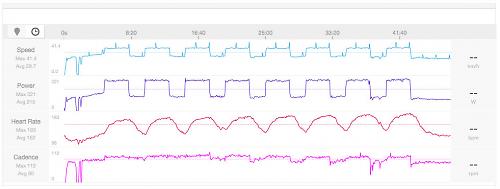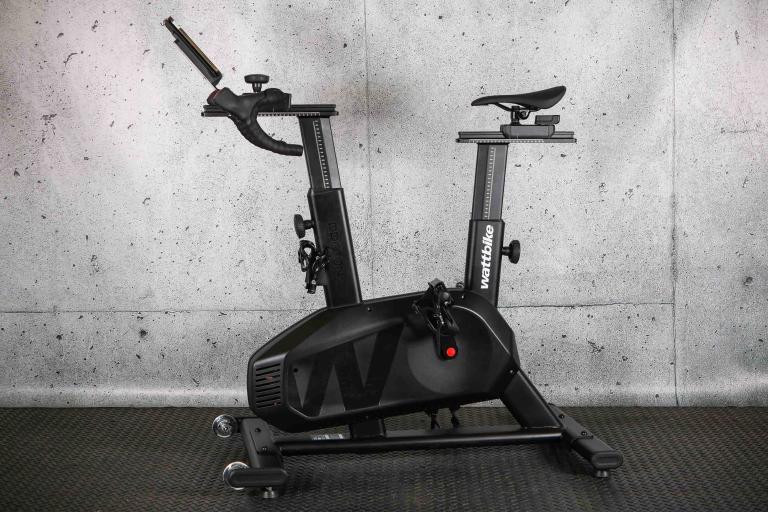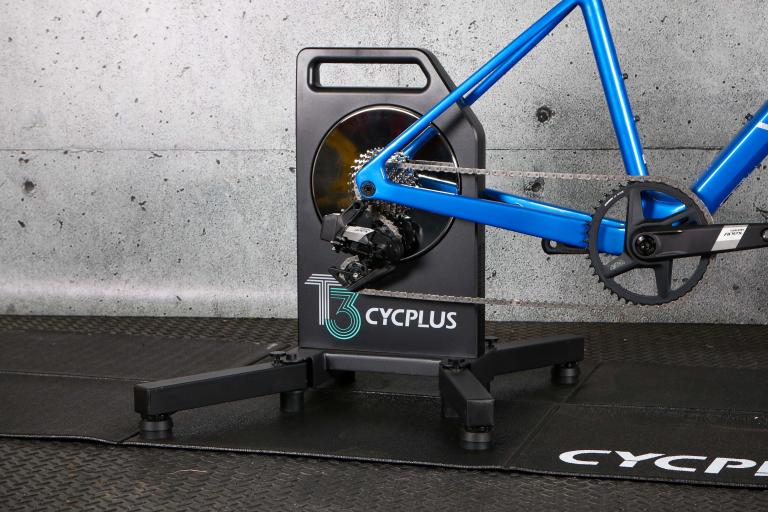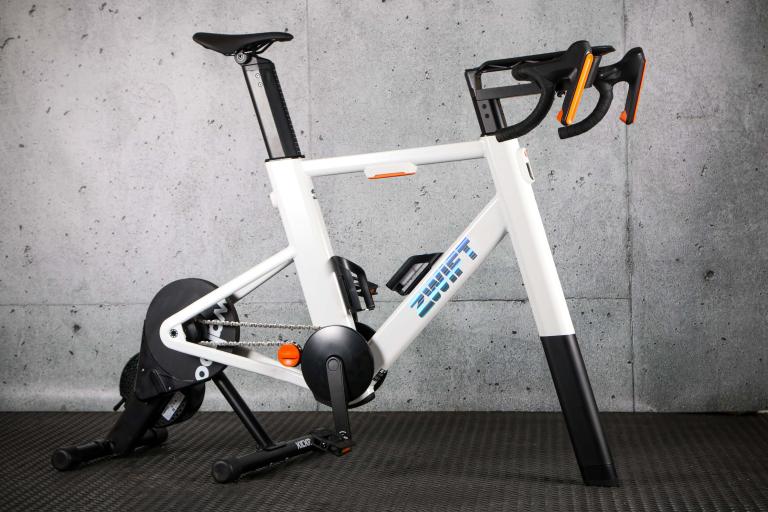- News
- Reviews
- Bikes
- Components
- Bar tape & grips
- Bottom brackets
- Brake & gear cables
- Brake & STI levers
- Brake pads & spares
- Brakes
- Cassettes & freewheels
- Chains
- Chainsets & chainrings
- Derailleurs - front
- Derailleurs - rear
- Forks
- Gear levers & shifters
- Groupsets
- Handlebars & extensions
- Headsets
- Hubs
- Inner tubes
- Pedals
- Quick releases & skewers
- Saddles
- Seatposts
- Stems
- Wheels
- Tyres
- Tubeless valves
- Accessories
- Accessories - misc
- Computer mounts
- Bags
- Bar ends
- Bike bags & cases
- Bottle cages
- Bottles
- Cameras
- Car racks
- Child seats
- Computers
- Glasses
- GPS units
- Helmets
- Lights - front
- Lights - rear
- Lights - sets
- Locks
- Mirrors
- Mudguards
- Racks
- Pumps & CO2 inflators
- Puncture kits
- Reflectives
- Smart watches
- Stands and racks
- Trailers
- Clothing
- Health, fitness and nutrition
- Tools and workshop
- Miscellaneous
- Buyers Guides
- Features
- Forum
- Recommends
- Podcast
review
£639.99
VERDICT:
As good a ride feel as any indoor trainer, and now with the option to measure power via your iPad or iPhone
Weight:
19,000g
Contact:
At road.cc every product is thoroughly tested for as long as it takes to get a proper insight into how well it works. Our reviewers are experienced cyclists that we trust to be objective. While we strive to ensure that opinions expressed are backed up by facts, reviews are by their nature an informed opinion, not a definitive verdict. We don't intentionally try to break anything (except locks) but we do try to look for weak points in any design. The overall score is not just an average of the other scores: it reflects both a product's function and value – with value determined by how a product compares with items of similar spec, quality, and price.
What the road.cc scores meanGood scores are more common than bad, because fortunately good products are more common than bad.
- Exceptional
- Excellent
- Very Good
- Good
- Quite good
- Average
- Not so good
- Poor
- Bad
- Appalling
I tested the original incarnation of the Rock and Roll trainer back in 2010 and I was impressed back then. The latest version, which allows you to use Kinetic's new inRide power measurement system (available separately, but we've tested them together) makes it even better. There are some questions about the value – specifically, the value of the inRide add-on – but none about the performance of the turbo, which is as good as it gets.
Kurt have a guaranteed leak-free resistance unit, which they use on all their trainers. It's completely sealed, and only connected to the flywheel and roller via a magnetic coupling. That coupling is so strong there's no danger of detaching it with a sprint effort, and the fact that the unit has no moving seals means there's very little that can go wrong. It gets an unconditional lifetime warranty to back it up.
The other standout feature of the Rock and Roll is that the whole of the trainer assembly is isolated from the base by a rubber bumper, which allows the bike to move about when you're climbing all over it on a hard effort. The trainer's wide footprint and 19kg all-in weight mean it stays put even when you're wobbling about on top. You can adjust the amount of wobble by tensioning up the bolts holding the top section to the bottom.

The idea is that the feel of riding is more natural, and also that riding the trainer engages your core muscles and helps to build strength there, as well as in your legs. A stable core means better power transfer to the pedals, too. Kurt have revised the base of the Rock and Roll so that it's not quite as wide as it was. Even so, it's still a good deal wider than a standard trainer, so if you're short on space it's probably not for you.
Different trainers are good at different things. What the Rock and Roll excelled at last time around was the riding feel. It really is about as good as they come. The sealed resistance unit is quiet, the large 6lb flywheel gives a smooth feel at the pedals and the suspended top section means the bike moves with you. It's really, really good. It works best with the riser that Kurt also sell, which allows the front wheel to pivot.
Kurt have done a lot of work on the power curve of the resistance unit so that it's easy to spin at low speeds and ramps up quite aggressively as you get faster, so there's plenty of resistance on hand without the need for adjustments.
All in all, the performance is similar to last time, which isn't a surprise as the trainer itself hasn't been radically updated. What has changed, however, is the ability to hook is up to an iPhone or iPad using the Kinetic inRide system, available separately for £175.
Kurt have always been happy that their resistance unit is built to sufficiently tight tolerances that you can extrapolate a meaningful power measurement from it; in the previous incarnation they supplied it with a wattage chart that was accurate to thousandths of a watt for a given speed. As I said in the earlier review, that's clearly nonsense: the trainer isn't the only source of resistance in the system and adjusting the tyre contact can significantly affect the drag. The inRide system takes all that into account though.
The package consists of a tiny magnet – which goes into the roller – and two bluetooth sensors, made by Wahoo Fitness. You get a heart rate monitor strap, and a sensor to stick on the back of the Rock and Roll to pick up the cadence of the roller. They both pair with Kinetic's new inRide app, which will work on both iPhone and iPad (there's no Android version). The cadence information is translated into both speed, and power, by the algorithms in the app.
Importantly, the app also factors in the quality of the tyre contact. For each workout you do (or series of workouts, if you're keen) there's a ten-minute warm-up followed by a roll-down test. You build up the speed to exactly 33.8km/h (a nice round figure) and then it tells you to stop pedalling. from the roll-down information gathered from that, the app adjusts the power algorithm for a given speed.
And does it work? Yes, it seems to. The Kurt gave me realistic and repeatable numbers when I was using it, and the inRide app is a pretty decent effort given it's a first go.
You can set up your own workouts to attempt. Currently I'm on a training plan that mostly involves riding intervals, so I set a few up to try. It's a bit of a laborious process getting all the information in there. You have to create each interval segment separately, and you enter the time, start power and finish power on a series of scrolling wheels. All power settings are expressed as a percentage of your Functional Threshold Power (FTP) so you'll need to know that, or at least be able to guess it. There's a preset workout in the app that'll give you a number.
The main thing you want power measurements to be is repeatable. If you can generate more power than before, or the same power for a given heart rate, then that looks a lot like progress. The baseline assumption though is that the figures are comparable. Given my experience of the Kinetic, I'd say that they are. Whether that 300W is actually 300W, or 280W or 320W, is less relevant; the process of doing a roll-down test before each session has delivered very consistent numbers for me. 300W on the trainer feels the same, and does the same things to me in terms of tiredness and heart rate, in a repeatable way.
The app allows you to define a series of data screens, with a frankly dizzying array of figures and metrics to put in the nine available slots. I won't list them here as there are too many, but it covers all the various ways you could describe speed, heart rate, power, time and intervals. You'll certainly be able to find the ones you want. You can leave slots empty if you want less data. You can set up heart rate and power zones for zonal training.

Once you've finished your session you can set it to automatically upload to Strava or TrainingPeaks, to keep track of your progress. I've been uploading to Strava, and the data the inRide app spits out is impressive. There's a few odd spikes in the speed graph (which seem to happen at consistent intervals), but other than that the data is excellent. The grab above is of a 8 x 3-minute interval session with a rising effort warm-up. Depending what training package you like to use, you can analyse your rides with whatever tools are at your disposal. I primarily like to just keep a record of what I've done.
The inRide kit, and app, bring a new dimension to the Rock and Roll. Where before it was a brilliant tool for the kind of person who likes to dedicate a winter to indoor riding and isn't too bothered about the numbers, inRide makes it a fully featured power trainer with simple sharing to your training tool. It's a really compelling package if you're not after video training or hill simulation.
It's not cheap though. £175 for the inRide kit seems a bit over the odds. Okay they've had to develop the app but the basis of that app – the power algorithm – already existed when the first Rock 'n' Roll came out. And the two Bluetooth sensors have a combined value of about £70. Given that, it's difficult to justify the full retail price, even though it does an excellent job. I've far fewer qualms about forking out £400+ for the trainer itself: it's an excellent unit that's built to last, with about the best ride feel you can get.
Verdict
As good a ride feel as any indoor trainer, and now with the option to measure power via your iPad or iPhone
road.cc test report
Make and model: Kurt Kinetic Rock and Roll 2 trainer + inRide kit
Size tested: Green
Tell us what the product is for, and who it's aimed at. What do the manufacturers say about it? How does that compare to your own feelings about it?
The Rock and Roll is a truly unique training experience. Its patented frame design provides the most realistic feel of any trainer available because it allows the bike to move as it does on the road. In addition to a superior ride, the Rock and Roll also provides the benefit of cycling-specific core training. By forcing the rider to maintain form on the bike, the Rock and Roll forces riders to stabilize themselves by using their core muscles. A stable core will help eliminate unnecessary upper-body movement, so that energy is used efficiently, and is key to riding a bike well. It will also stabilize the pelvis, gives the riders' legs a solid fulcrum to act against, efficiently transferring power to the pedals.
Tell us some more about the technical aspects of the product?
* The most realistic indoor ride available
* Power training + Core training = Rock and Roll
* Compatible with Kinetic inRide Watt Meter for power training
* Unmatched stability and durability
* Lifetime warranty
* Add Turntable Riser Ring for the best ride feel
* Patented Kinetic fluid resistance provides measurable and repeatable workload
* Progressive resistance from 5 to 3000+ watts
* Easy assembly''just tighten on extension legs
* Ergonomic rubberized knobs grip for easy setup
* Fits 22' to 29' wheels''up to 29 x 2.4' tires sizes
* Lifetime Warranty & Crash Replacement Policy
* Recommended Kinetic accessories: Turntable Riser Ring, Trainer Bag, Trainer Mat, and Pro Flywheel
Rate the product for quality of construction:
10/10
Rate the product for performance:
9/10
Rate the product for durability:
10/10
Rate the product for weight, if applicable:
10/10
Assuming heavy = good, that is.
Rate the product for comfort, if applicable:
8/10
Rate the product for value:
6/10
Trainer is good value, inRide system less so.
Tell us how the product performed overall when used for its designed purpose
Very well.
Tell us what you particularly liked about the product
Great ride feel, repeatable numbers.
Tell us what you particularly disliked about the product
inRide kit is expensive.
Did you enjoy using the product? Yes.
Would you consider buying the product? Yes.
Would you recommend the product to a friend? Yes.
Anything further to say about the product in conclusion?
The trainer on its own warrants a 9/10. The inRide system works well and the app is a very useful addition, but £175 is well over the odds, so it loses a mark overall for that.
About the tester
Age: 42 Height: 190cm Weight: 100kg
I usually ride: whatever I'm testing... My best bike is: Kinesis Tripster ATR
I've been riding for: Over 20 years I ride: Every day I would class myself as: Experienced
I regularly do the following types of riding: road racing, commuting, club rides, sportives, general fitness riding, fixed/singlespeed, mtb, Mountain Bike Bog Snorkelling, track
Dave is a founding father of road.cc, having previously worked on Cycling Plus and What Mountain Bike magazines back in the day. He also writes about e-bikes for our sister publication ebiketips. He's won three mountain bike bog snorkelling World Championships, and races at the back of the third cats.
Latest Comments
- CrisPH 38 min 19 sec ago
Would it just be simpler to have a zero VAT band for bikes up to a certain price, and key accessories like helmets, lights, locks etc - than having...
- velodinho 55 min 12 sec ago
As witnessed at so many infrastructure improvement projects similar to this one, all those who object should ignore the consultation and pray at...
- Nagai74 2 hours 43 min ago
It's a DLO to those in the trade.
- chrisonabike 2 hours 58 min ago
Surely as a former bridleway these should be equid-based e.g. "hoof-depth" / "up to the fetlock" / "approaching hock/knee"?...
- Tom_77 3 hours 22 min ago
Cars keep getting wider and wider, but it's those damn cyclists with their wide handlebars that are the real problem. ref
- bikes 4 hours 19 min ago
"it's almost entirely from recycled composite materials". What percentage of the carbon frame is made from recycled carbon?
- David9694 8 hours 18 min ago
Motorist Mike demands 40p back after overcharged on new £11m 'prison' car park...
- PRSboy 21 hours 23 min ago
I have two aero bikes- an Argon18 Nitrogen and an Orro Venturi. I love the way they feel on the road. I also like the style of the deeper section...
- Rendel Harris 1 day 5 hours ago
They have here: results at 14.40. The aero bike was roughly fifteen seconds faster than a climbing bike on a descent of around 6 km, so about 3km/h...
- wtjs 1 day 5 hours ago
As I've also placed here the nutter Audi and white van drivers, I've decided to give those no-nonsense keep-the-country-moving BMW drivers a list...








Add new comment
8 comments
Here is top 10 exercise bikes that you have to buy for indoor exercise check out http://reviewspack.com/best-exercise-bikes/
I have a Kurt Kinetic Road Machine and use it with Trainerroad - works a treat!
Right. So what Giobox seems to be saying is that in order to get accurate, replicable power without variability / needing to be pedantic about pressures and resistance, go for the InRide?
Thing is, InRide doesn't give what TrainerRoad seems to.
So ideally, do I need *both*?
Gnnarrggh!
Wondering if you'd be better off just buying the trainer and a Trainerroad.com subscription?
I wondered about getting one when they came out - I fancied the idea of reasonably accurate power reading, without some of the vagaries of VP, especially in sprints and high accelerations. That's really all the difference between the two though...
However, like an awful lot of people, I didn't want to be forced to buy an over-priced heart rate monitor nor have everything Bluetooth only. Most of the enquiries about that with Kurt I saw (including my own) just got a standard "No plans at all at the moment for ANT+ or stand-alone sensor - we'll maybe look in the future" comment - didn't sound particularly sincere to me, more like a brush-off. That sealed it for me....
What's frustrating is that this is really just a software issue - you could use any old sensor (ANT+ or otherwise) on the drum to get a better speed / acceleration reading and the rest is just a quick calculation from the power curve, see e.g. the ANTride concept from Keith Wakeham (now at 4iiii)
http://keithhack.blogspot.co.uk/2013/09/quar-ccuity-or-accuiq-and-antrid...
With that in mind I personally find the price offensive (even given the application costs), and it stopped me from considering it - I know i'm far from alone in that regard. Think they dropped one on this....
Not really. The big advantage of the inRide design is that in addition to placing the magnet on the trainer flywheel, you can do a "spin down" calibration. This allows the power reading to compensate for how tightly the rear wheel presses against the turbo trainer. Effectively it just times amount of time it takes the trainer to spin down from a given speed, and adjusts the power number output accordingly. VP doesn't do this, which is why Trainerroad's VP numbers can be made to vary quite significantly for the same cadence and trainer resistance setting just by tightening the dial on the trainer or adjusting tire pressure.
Its the inability to account for the pressure at the trainer that makes VP a crapshoot, not so much sprints and high accelerations. I've found if you are very careful at counting the number of turns applied to the tension adjuster and checking tire pressure before each use you can get reasonably consistent numbers, but its still not ideal. the inRide fixes these shortcomings.
Kurt have at least partially addressed this issue - they now sell the inRide pod on its own without the HR strap.
https://kurtkinetic.com/products/kinetic-inride-pod-only/
I do agree though, the price for what is essentially just a Bluetooth cadence sensor is high, but in the context of price to consistency of measurements, its still the easily the best price-to-consistency ratio out there for now, which is why I was prepared to stomach the cost.
It would be great for a third party - trainerroad themselves perhaps? - to step up and build a generic version of this that takes advantage of a wide range of trainer's known power curves.
Ah ! Missed that - thanks for heads-up.
Fair enough - just doesn't quite add up for me but understand where you're coming from.
..one big step forward would be the roll-down on TR, pity about the delay given that IIRC they had a skunk version working a looong time ago (mentioned on one of the ideas pages) but they've certainly been busy with other stuff, so not totally surprising alas.
Hardware side, things should be OK - as a hack, maybe need to be able to pair two cadence sensors and use one for the high frequency readings from the wheel drum. Hmmmm - you've got me thinking about this again, time to get simulANT+ fired up once more......
This review misses some important points about the inRide. It's worth pointing out that trainerroad.com also supports the Kurt inRide power meter, so you can use it with a PC or Mac too, not just iPhones and the Kurt app. The inRide also works with several different Kurt models, not just the very expensive Rock 'N' Roll trainer in this review. I'm using it with the Road Machine.
I've had one for a while and the new iOS app is a massive improvement, for ages the old app crashed all the time on iOS 7 so I mainly stuck to using it with Trainerroad. The price is arguably not too bad when you consider the results are pretty much spot on with a PowerTap I compared to, so you are getting measurements that otherwise would cost in the region of ~$1000 for something like a Stages or Vector S.